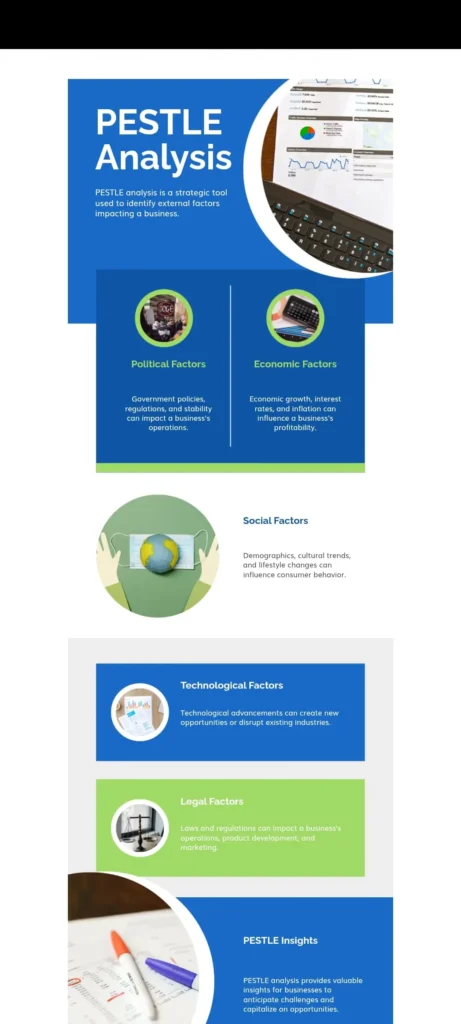Maximizing Business Potential with the PESTLE Model
See how a simple yet powerful model can help individuals and businesses navigate in turbulent times.

The PESTLE model helps businesses understand the world around them. It looks at external factors that can affect success. PESTLE stands for:
- Political
- Economic
- Social
- Technological
- Legal
- Environmental
Why is PESTLE Important?
Knowing about these outside factors is key for long-term business success. PESTLE helps you:
- Understand your business environment: PESTLE looks at the big picture to see what’s happening outside your company.
- Identify important external factors.
- Make smart decisions: It helps you plan your strategy, manage risks, and understand your market.
- Adapt to changes in the market. It can help you plan your workforce and manage changes in your organization.
The Six Parts of PESTLE
Let’s look at each part of the PESTLE model:
1. Political Factors
- What it is: Government laws, rules, and political stability.
- Examples: Trade deals, tax laws, labor rules, and political unrest.
- Impact: Political factors can help or hurt your business. Good trade deals can boost sales. Strict rules can make it harder to operate.
- How to assess: Stay informed about government changes. Watch the news and talk to experts. Consider political risks in different regions.
2. Economic Factors
- What it is: Economic conditions like inflation, interest rates, and growth.
- Examples: GDP, unemployment, consumer spending, and exchange rates.
- Impact: Economic factors affect how much people spend and your access to funding. A weak economy can lower sales. A strong economy can create growth.
- How to assess: Track economic trends. Consult experts. Consider how inflation and interest rates might affect your finances.
3. Social Factors
- What it is: Social and cultural trends, like demographics, lifestyles, and values.
- Examples: Population changes, lifestyle shifts, cultural beliefs, and health attitudes.
- Impact: Social factors affect what people buy. Changing trends impact demand and preferences.
- How to assess: Do market research. Follow trends and cultural shifts. Consider how social factors affect your target customers.

4. Technological Factors
- What it is: New technologies and innovations.
- Examples: Advances in communication, transportation, and manufacturing.
- Impact: Technology can boost efficiency, lower costs, and create new opportunities.
- How to assess: Stay updated on industry tech. Attend events and talk to experts. Consider how tech affects your business and customers.
5. Legal Factors
- What it is: Laws and regulations that affect businesses.
- Examples: Health and safety rules, data protection laws, environmental regulations, consumer protection laws, and tax laws.
- Impact: Breaking laws can lead to fines or legal action.
- How to assess: Know the relevant laws. Consult legal experts. Conduct regular audits and stay updated on legal changes.
6. Environmental Factors
- What it is: Natural conditions and how they affect your business.
- Examples: Climate, natural disasters, waste management, pollution, and sustainability.
- Impact: Environmental issues can raise costs, disrupt operations, and damage your reputation.
- How to assess: Understand environmental laws. Review your waste practices. Analyze the impact of weather. Monitor public opinion on environmental issues.
PESTLE: The Big Picture
- PESTLE helps you analyze outside factors that can impact your business.
- It covers political, economic, social, technological, legal, and environmental factors.
- Each factor provides insights to help you make informed decisions.
Benefits of PESTLE
- Helps you understand external influences.
- Supports informed decision-making.
- Useful for short-term and long-term planning.
Is PESTLE Useful for Small Businesses and Startups?
Absolutely! PESTLE is a great tool for even the smallest businesses. Here’s why:
- Understand the World: Small businesses are affected by the outside world, like new laws, the economy, and changing trends. PESTLE helps you see these influences.
- Plan Your Strategy: For startups, PESTLE helps you see opportunities and threats in the market. This helps you set realistic goals and create a good business plan.
- Manage Risks: PESTLE helps you spot potential risks, like new regulations or a bad economy. This lets you prepare for problems before they happen.
- Find Your Place in the Market: By understanding technology and social trends, PESTLE helps you sell the right products to the right people.
- Use Your Resources Wisely: PESTLE helps you decide where to spend your time and money, so you focus on the most important things.
PESTLE helps small businesses and startups make smart choices, manage risks, and find their place in the market.
PESTLE in Action: Real-World Examples
PESTLE isn’t just for big corporations. Here are some lesser known companies using PESTLE to succeed:
Beyond Meat (Plant-Based Meat)
-
- Political: Benefits from government support for reducing meat consumption.
- Economic: Growing market for vegan meat means more sales.
- Social: More people are becoming vegan and caring about the environment.
Warby Parker (Eyeglasses)
-
- Political: Navigates healthcare rules about vision care.
- Economic: Adjusts prices based on how much people are spending.
- Technological: Uses online try-on tools to make shopping easier.
Ecovative Design (Sustainable Materials)
-
- Political: Benefits from government programs that support eco-friendly businesses.
- Economic: Demand for sustainable packaging is increasing, driving growth.
- Environmental: Uses eco-friendly materials, which consumers love.
Patagonia Provisions (Sustainable Food)
-
- Political: Supports environmental causes, which improves its brand.
- Social: People want ethically sourced, sustainable food.
- Technological: Uses new technology to make its food production more sustainable.
What This Means
These companies show that any business can use PESTLE to understand the world around them, find opportunities, and avoid risks. It’s a smart way to stay ahead!
PESTLE vs. SWOT: What’s the Difference?
PESTLE and SWOT are both tools to help businesses plan. But they look at different things. SWOT looks at what’s happening inside and outside your company.
PESTLE focuses only on the outside world.
Here’s a simple comparison:
| Feature | PESTLE Analysis | SWOT Analysis |
|---|---|---|
| Focus | External Factors: Political, Economic, Social, Technological, Legal, Environmental | Internal & External: Strengths, Weaknesses, Opportunities, Threats |
| What it Examines | Big-picture trends & changes outside the company. | A mix of company’s internal situation with the external world. |
| Purpose | Understand the external environment and its impact. | Identify internal strengths/weaknesses & external opportunities/threats to make a strategy. |
| Depth | Detailed look at external factors. | Less detailed look at external factors, more focused on the bigger picture. |
How to Use Them Together
Using both PESTLE and SWOT is a smart move. Do a PESTLE analysis first to understand the world around you.
Then, use that information to help you identify the Opportunities and Threats in your SWOT analysis.
This will help you create a stronger, more informed business strategy.
In short: PESTLE helps you see the landscape, and SWOT helps you decide where to go within that landscape.
Final Thoughts
PESTLE is a powerful tool to stay ahead. As a leader and business owner it is imperative to know these factors, so that you can better understand your environment and make smart choices for growth and success.
PESTLE is an essential tool to for better managing your business in highly regulated and competitive business environment.




